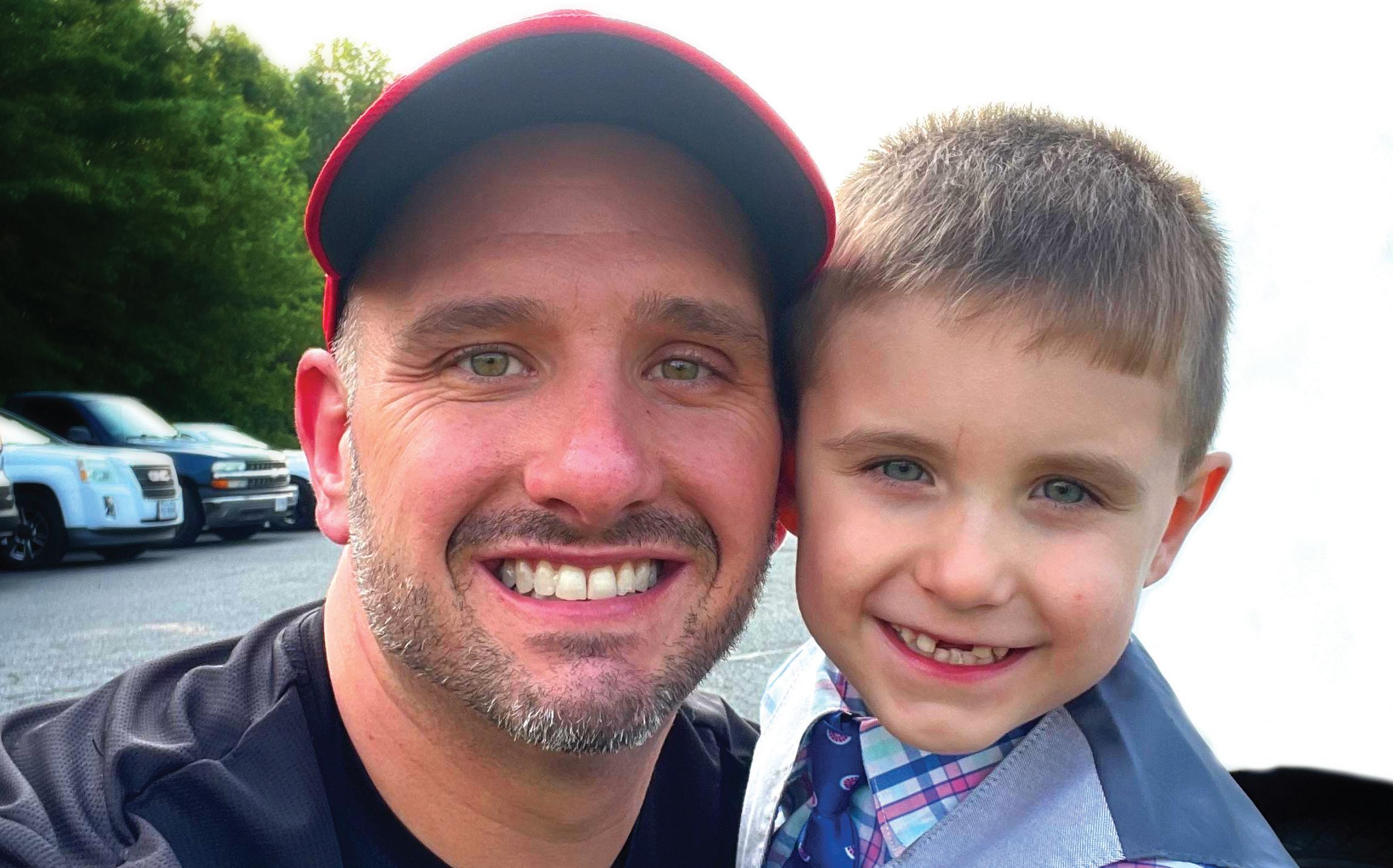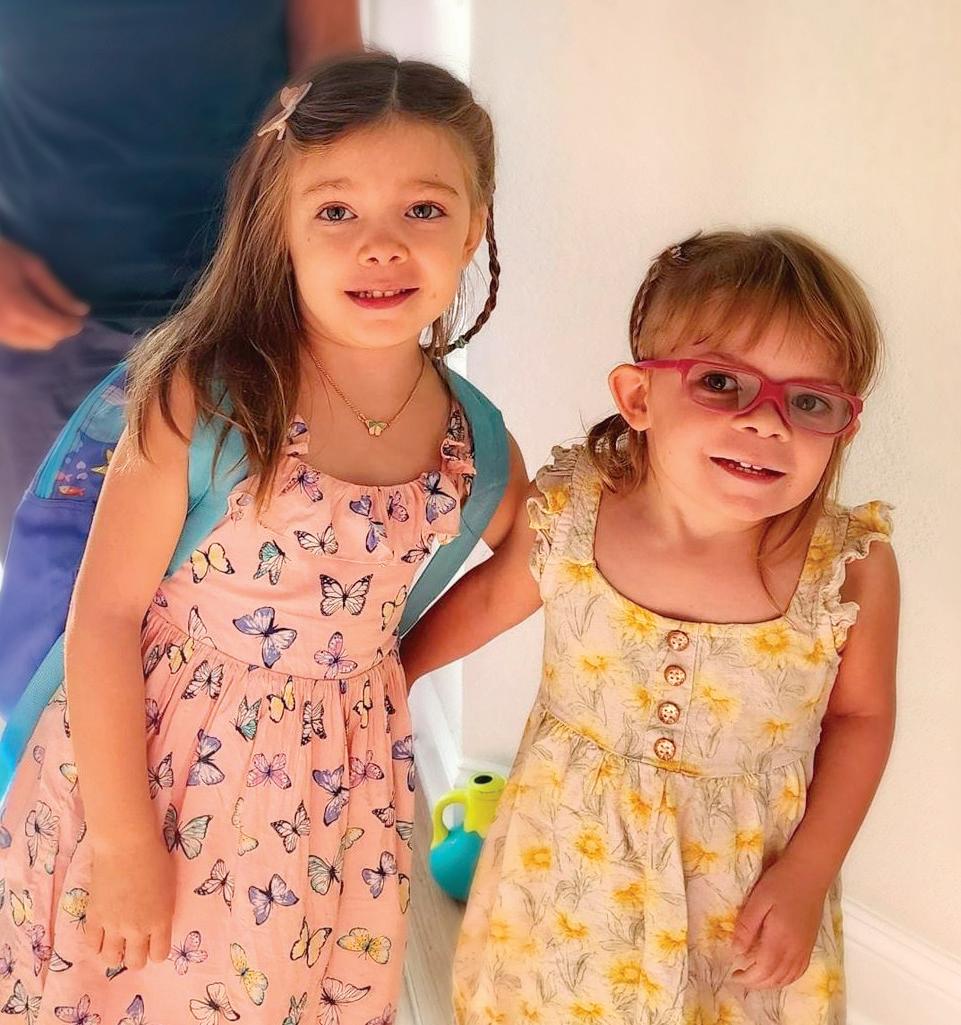



Antecedent, Behavior, and Consequence in ABA Therapy saga of sun kissed splashes Acoe n Lv: A Lte o y Hby Journey Through Turmoil

For the Ones Where it Doesn’t Come Easy
“ Perhaps I should be smiling right now?
Why do others around me laugh?
Well I guess I’ll just have to follow their lead
It’s like they’re all mice and I’m a misfit giraffe!
All these social cues don’t come easy for me
Words, sounds, smells, tastes and touch
A constant brain banging cacophony
Plagues a person like me VERY much!
All the “appropriate” societal norms
Are my daily painful bane
So forgive my inattentiveness
While I just struggle to stay sane!!
I know you feel you must label me
Autistic, Aspie, Asperger and more
Art
Public Relations Manager | Ava Martinez
Add. Contributors
Grace Mitchell
Benjamin Chen
Emily Wilson
Alexandra Taylor
Special Thanks
We extend our heartfelt gratitude to all those who contributed to this issue, directly or indirectly.
Management
How about, you just call me by my name?
Now THAT I would monumentally adore!!
Just know that I’m certainly not at all trying
To be rude, mean or treat you unkind
It’s just that this fickle brain in here
Is one helluva unique complex mind
So please when you happen to meet folks like me
Just know that for us life can be tough
The things that come so easily for you
For us, can be horrifically rough
Just give us folks more time to figure it out
Show compassion when we seem to melt down
And know that we feel, we cry, we hurt and we need
Your accepting smile not your disparaging frown ”
Gary Shulman
Subscription
Sponsored by



14 : Navigating the Night: A Guide to Calm Sleep
15 : Unlocking Connection: Embracing Parenting Journey
16 - 17 : Whispers of a Unique Symphony: A Parent’s Tale
12 - 13 : A Letter to my Hubby: Anchored in Love


18 - 19 : Journey Through Turmoil
20 - 21 : Antecedent, Behavior, and Consequence
22 - 25 : Building Strong Connections
26 - 28 : Embracing
30 - 32 : Why What How
34 - 35 : Emma : Tale of Empathy and Support in the Daycare Journey
36 - 39 : Photos
06 08 12
- 07 : Editors Picks CONTENTS Creative programs for those on the autism spectrum
Team
|Sojan George k Content Editors | Eleanor Bennett Jonathan
|Sophie
06
Editorial
Editor-in-Chief
Parker
Chang
| Jojan Graphic
| Miles Turner | Isabella
& Design Team Art Director
Designers
Lee
Communication Team Communication Director | Nathan Reynolds
CEO | Manju George COO | Jojan CFO |Hannin Ikes
For subscription inquiries, please contact: magkaletidoscope@gmail.com
02 - 03
Navigating the Night: A Guide to Calm Sleep
Our Team 08 :
Neurodiversity: Embracing Empathy
Time Pass
- 11 : Saga of Sun Kissed Splashes
40 - 46 :
10

Get Involved: Share Your Voice!
Have a burning question about autism? A personal story that could inspire others? Or perhaps some snapshots capturing special moments? Send them our way!
Your input adds depth and richness to our magazine, creating a space that truly reflects the collective spirit of our community. Don’t hesitate—your voice matters, and we can’t wait to feature your unique perspectives!
Sent to :
FROM THE EDITOR
Ahoy, Dear Readers!
As February unfolds its tender petals, our magazine sets sail on a journey adorned with tales of sun-kissed splashes and the unique symphony of parenthood. This month, we immerse ourselves in the harmony of diverse stories, embracing the challenges and triumphs that weave the fabric of our shared experiences.
In ‘The Sleep Struggle: Harmony in Parenthood,’ we dive into the challenges of bedtime routines, unraveling the intricacies of a peaceful night’s rest. Join us in exploring the lullabies of love and the tender whispers that guide us through the nocturnal adventures of parenting.

‘A Letter to my Hubby: Anchored in Love’ takes you on an emotional voyage as a mother shares her heart with her partner, unraveling the daily routine and challenges of parenting a child with autism. It’s a testament to the power of support, patience, and the enduring strength found in the embrace of love.
Our feature, ‘Navigating the Night: A Guide to Calm Sleep,’ serves as a beacon for tired parents seeking solace in the moonlit waves of bedtime struggles. We offer insights, tips, and a comforting hand to guide you through the sometimes turbulent waters of bedtime routines.
In ‘Journey Through Turmoil,’ we delve into the challenges faced by parents with neurodivergent children, unraveling the threads of resilience, courage, and the unwavering spirit that propels them forward. It’s an exploration of strength amid the storms, proving that even in adversity, the human spirit can triumph.
Contributors
A big thank you to everyone who adds to our magazine! Your stories and thoughts make our community special. We love hearing from you because each story is like a friendly guide for others. Your ideas and experiences help us all connect and understand each other better. So, thank you for being a crucial part of our Autism Support family!
Autism Support Group Top Contributors
And in our special feature, ‘Emma: Tale of Empathy and Support in the Daycare Journey,’ we bring you a heartwarming story of a daycare teacher’s journey with a child facing potential autism. It’s a testament to the impact that understanding, support, and a caring environment can have on a child’s development.
As the captain of this literary ship, I invite you to embark on this captivating voyage with us. Let these stories be the wind in your sails, guiding you through the highs and lows of parenthood. May you find solace, inspiration, and a sense of camaraderie in the pages that follow.
Fair winds and following seas,


Special Thanks

The Autistic Singer








FROM THE EDITOR 04 - 05
GEORGE
Allie Libby
Lc-Tony De La Vega
Jayme Lancaster
Savanah Jauss
Miguel Angel Perez
Shardae Oladeji-Wilson
Jennifer Kinder
Kia Roe
Kevin Perez
magkaleidoscope@gmail.com
EDITORS Pick

Creative programs for those on the autism spectrum
AIslands of Brilliance, an organization providing creative programs for those on the autism spectrum, is coming to Eau Claire.
“We’re doing training for a new program that we’re bringing to the area called The Fellowship. So we have fellows who are going to be running programing here from six different communities. So Eau Claire, Rice Lake, Wausau, Tomahawk, La Crosse and Viroqua,” Co founder and Executive Director Mark Fairbanks said.
Organizers came together Saturday to start training educators and artists in preparation for the upcoming sessions.
“It’ll be an open ended opportunity for just creation without constraint and also creation with a framework or a theme or having this pre-established foundation,” Artist, August Carlson said.




Dialectical behavior therapy: What is it and who can it help? Sleep disorders found to differ for autism, ADHD versus typical development
DBT focuses on teaching people skills to manage intense emotions, cope with challenging situations, and improve their relationships. It encourages people to learn and use mindfulness training in practical ways.
During individual and group sessions, therapists encourage a nonjudgmental attitude and emphasize acceptance, compassion, and other aspects of mindfulness.
For most types of sleep disorders, there are significant differences for children with autism spectrum disorder (ASD) and those with attention-deficit/hyperactivity disorder (ADHD) compared with typically developing (TD) children, according to a study published online Dec. 29 in Autism Research.

The sessions are meant to provide an environment where those on the autism spectrum can let their creative side free, without feeling the need to constrain themselves.
“It’s really targeting what we call a transition age into adulthood. When they graduate from high school, there’s a lack of opportunities. So we are really filling this need in this early adulthood phase for community creativity, gathering, shared interest, things like that,” Fairbanks said.
“
“ We’re doing training for a new program that we’re bringing to the area
Who may benefit from DBT?
DBT has a proven track record for addressing the most debilitating symptoms of borderline personality disorder: selfinjury and suicide threats or attempts. It is now also used to treat depression, posttraumatic stress disorder, eating disorders, and substance use disorders.
In fact, the cornerstone of DBT — the skills training — can help anyone navigate emotionally charged situations with more ease.
How can mindfulness change how people experience strong emotions?
Many people in therapy have very strong emotions that lead to negative thoughts, says Dr. Blaise Aguirre, a psychiatrist who founded the 3 East Dialectic Behavior Therapy Continuum at Harvard-affiliated McLean Hospital. “They say things like, ‘I’m stupid,’ or ‘I can’t control my anger,’ or ‘No one will ever love me,’” he says.
Carmen Berenguer, Ph.D., from the Universitat de València in Spain, and colleagues examined the differences in sleep problems among a group of children with ASD without intellectual disabilities, a group with ADHD, and a TD group (47, 43, and 32 children, respectively; aged 7 to 12 years) matched on age and intelligence. Questionnaires measuring sleep disturbances and communication skills were completed by parents.
The researchers identified significant differences in most types of sleep disorders between the ASD and ADHD groups and the TD group. The group with ADHD showed significantly more sleep breathing disorders and hyperhidrosis compared with the ASD and TD groups, as well as more total sleep problems. Compared with the ASD group, the ADHD group had greater predictive power of sleep problems on communication difficulties. Sleep problems were found to partially mediate the association between symptoms and communication in both groups.
“Understanding the sleep dysfunctions that occur in both conditions and their repercussion in other areas such as communication is crucial for developing tailored interventions that reduce the adverse consequences of sleep disturbances,” the authors write.
GIBBSBORO, NJ. – GentleCare Therapy is excited to announce that they’re expanding to support families in need of autism-related therapeutic services in New Jersey. This expansion provides them with the opportunity to serve children in and around Camden, Gloucester, and Burlington counties for home, community, and center-based ABA services out of their brand-new autism treatment center located in Gibbsboro, NJ.
In addition to ABA Therapy, the treatment center will offer Speech and Occupational Therapy, providing comprehensive autism care.
The center will be located at 88 S Lakeview Drive, Gibbsboro, NJ 08026.
The new Gibbsboro treatment center has been completely revamped into a stateof-the-art treatment center equipped with clinical treatment rooms, a play gym, training rooms, and more.
Led by our Senior Clinical Director; Dr. Casey Nottingham, the center will draw from the latest research to continue crafting programming in New Jersey that builds resilience, unlocks communication, grows skills and nurtures confidence. “We’re especially excited to expand GentleCare Therapy into New Jersey to serve as a resource for numerous families who are seeking support and guidance following an autism diagnosis,” says Dr. Nottingham. “Our primary focus is to help kids in our community pursue their unique interests and goals by creating a loving, reliable, and enriching environment where they can learn and play in the ways that best suit them.”
Golisano Children’s Hospital of Southwest Florida, in partnership with Ronald McDonald House Charities® of Southwest Florida, offers a free monthly autism spectrum disorder screening for toddlers 18 months to five years of age.
The next screening will be held on Feb. 23, from 9 a.m. to 2 p.m. at the Pediatric Specialist Office, 15901 Bass Rd, Suite 102, Fort Myers.
It is estimated that one in every 44 children is diagnosed with some form of Autism Spectrum Disorder, making it more common than childhood cancer, juvenile diabetes and pediatric AIDS combined.
Medical consultants for the project stress that an early diagnosis can make a vast difference for toddlers and their families. They say early intensive behavioral intervention can make an immense difference not just in the development of the child, but in their families as well.
The ASD screening is conducted by the Golisano Children’s Hospital of Southwest Florida. The screenings are administered by an Advanced Practice Registered Nurse, who has extensive training and experience in typical child development and developmental disorders.
A physician referral is not required. To schedule a screening, please call 239-3436838.
EDITORS PICK 06 - 07
Links
autism-screening-for-young-children-febru-
Related
https://southfloridahospitalnews.com/free-
ary-23-2024/
GentleCare Therapy Opens New Autism Treatment Center in Camden
FREE AUTISM SCREENING FOR YOUNG CHILDREN –FEBRUARY 23, 2024
County
The Sleep Struggle: Harmony in Parenthood

“
I’m not good because you got upset.
“
In the middle of the parenting chaos, I got myself caught up in the whole putting-the-kid-to-sleep conundrum.
The breaking point hit hard one night, a whopping five hours deep into the struggle. Frustration got the better of me, and I let out a yell, casting a gloom over the room.
My little one, innocence dripping from his eyes, dropped a truth bomb, saying, “I’m not good because you got upset.” Guilt hit me like a ton of bricks, and it was high time for a change. How could I keep my cool and turn bedtime from a battleground to a peaceful ritual?
In my quest for a solution, I stumbled upon another parent’s nugget of wisdom – the magic of a bedtime movie routine. Intrigued, I decided to weave this into our nightly saga.
The bedtime routine underwent a cinematic makeover. The soft glow of the screen lit up the room as we embarked on a journey together. Nestled beside my offspring, I created a snug haven where we could unwind collectively. It became a moment to share, giggle, and just exist in
each other’s company.
As the youngest succumbed to the gentle embrace of sleep, I whispered to the older one, setting a designated time for the movie’s end – a subtle reminder of the impending bedtime. What used to be a struggle morphed into a familiar routine, a shared experience that brought us closer.
Through this new approach, bedtime ceased to be a battleground; it transformed into a serene culmination of our day. My children, now accustomed to the comforting glow of a movie before sleep, drifted off peacefully, and the nightly chaos morphed into moments of bonding.
In the narrative of parenting, I learned a crucial chapter – that good and bad days are part of the journey. Apologies became a powerful tool, a bridge to healing after moments of frustration. I approached my son, acknowledging my shortcomings and expressing remorse.
“Mommy had a bad moment of frustration and yelled,” I admitted. “Let’s work together to make bedtime a special time for both of us, ensuring you get the rest you need.”
In this story, I found solace in the realization that parenting is a continuous journey of growth, learning, and adapting. Through a simple adjustment in our routine, the bedtime struggle transformed into a harmonious symphony, a reminder that even in moments of discord, we can find a melody of connection and love.
And so, the tale continues, with each night becoming a shared adventure of movies, laughter, and the unwavering bond between a parent and their children.

THE SLEEP STRUGGLE
Courtesy to Amber Nicole
saga of sun kissed splashes
Ahoy there, dear readers!
Gather around, and let me regale you with a tale from the deep, a salty saga of sun-kissed splashes and stormy emotions. I am your storyteller, Amelia the Aquawolf, and today, we embark on a journey into the turbulent seas of understanding and connection with a remarkable young sailor named Ben.
Ben, a spirited nine-year-old, wasn’t your average cabin boy. His laughter could silence a kraken’s roar, and his eyes held the secrets of hidden coral reefs. But like any sea, his emotions were vast and unpredictable. Sometimes, the sun in his smile dipped below the horizon, turning joy into a squall.
One breezy afternoon, as we charted a course through the deep-sea trenches, a storm hit. Ben, usually my first mate in laughter and exploration, turned into a hurricane, lashing out like a rogue wave. His fists connected with my shoulder like cannonballs, and fear, cold and clammy, wrapped around me tighter than a kelp knot.
Had I pushed him too far?
Was this uncharted territory, a hidden reef of danger in his emotions? The thought of abandoning ship, of leaving him to navigate the churning currents of his feelings alone, gnawed at me like a remora on a treasure gal-

“
“ Kick your legs first or raise the Jolly Roger?
leon. But giving up? Not in this salty dog’s blood! Ben needed me, not just to stay afloat, but to understand the unpredictable tides of his heart.
So, I took a deep breath, swallowed my fear, and dove headfirst into a different kind of treasure map.
Reading the Emotional Storm
First and foremost, I became Ben’s weatherwoman. I learned to read the storm clouds in his eyes, the tremor in his hands, the way his gaze flickered like a ship’s lantern caught in a fog. Instead of barking orders like a grumpy sea captain, I offered choices, little life rafts in the ocean of instructions.
“Kick your legs first or raise the Jolly Roger?” I’d ask, my voice a soothing tide amidst the chaos. This meant chucking the rigid logbook and embracing the wild winds of his attention span.
Building a Coral Reef of Safety
Second, I built a coral reef of safety. Deep water became a distant myth; we were explorers in the shallows, discovering the joy of splashing and giggling without the fear of kraken attacks. Every mastered stroke, every shared giggle, was a victory lap, a reminder that patience and understanding were my sturdiest anchors.

Let’s dive headfirst into the world of neurodiversity, not with fear, but with open hearts and a willingness to learn. Together, we can build a world where every wave whispers not of danger, but of possibility. A Message to All
the Bens Out There
And to all the Bens out there, sailing through your own storms, remember this: you are braver than you think, stronger than you feel, and loved more than you know.
Just keep swimming, one paddle stroke at a time, and trust that there’s always someone there to hold your hand through the rough waters.
Now, about that outburst. Ben wasn’t being a bad pirate; he was overwhelmed. His senses were like fireworks exploding all at once. Maybe he didn’t understand the danger in his actions, like a young bird mistaking a stormy sea for a playful puddle. Or perhaps, his focus was so tightly locked on a shimmering treasure chest at the bottom that my words just floated away like bubbles.
So, I tossed the punishment plank overboard. Instead, I built bridges. A quiet cove in the shade, a gentle squeeze of his hand, a silent acknowledgment of the storm brewing within – these became my tools. And slowly, the waves subsided, replaced by a calm sea of trust.
Smooth Sailing Amidst Challenges
It wasn’t always smooth sailing. There were tears, splashes, and even the occasional accidental cannon blast
(turns out, Ben has a mean left hook in the shallows). But with each challenge, we grew closer, our bond stronger than an anchor chain.
The water, once a battleground, became our shared treasure map, a place where anxieties dissolved and triumphs sparkled like buried gold.
And then, one glorious afternoon, Ben did it. He mastered the freestyle, his laughter echoing like a joyous pirate shanty. It wasn’t just about swimming; it was about trust, about understanding, about proving that even the most challenging currents can be navigated with kindness and patience.
So, my fellow instructors, caregivers, and anyone who feels lost in the stormy seas of life, remember this: your empathy is your compass. With it, you can guide even the most bewildered souls to their own shores of success.
Now, if you’ll excuse me, I have a mutiny of mermaids waiting to learn the backstroke! Remember, keep calm and swim on!
In this tale of the high seas, we navigated the intricacies of understanding and connecting with a neurodivergent soul. Ben’s journey was not just about conquering the waves but about forging a bond anchored in empathy and acceptance.
May the lessons learned in these deep waters ripple far and wide, fostering a world where every sailor, regardless of the storms within, finds safe harbors and open seas of possibility.
SUN KISSED SPLASHES 10 - 11
A Letter to my Hubby: Anchored in Love





































My Dearest Peter









hope this letter finds you well amidst the hustle and bustle of our daily lives. As I sit down to pen my thoughts I feel a wave of emotions a mix of love concern and the profound desire for understanding.
Our journey with our little ones especially our precious daughter is nothing short of an adventure –





understand the demands our household places on us – the constant juggle with the needs of our little tribe. With Jessy on the autism spectrum and the twins demanding their share of attention, our days are a delicate balance. It is not lost on me that you share this burden that you strive to be the pillar of support for our family.

In these trying moments my dear what I yearn for is not a solution but your understanding. need you to see beyond the tears beyond the seemingly unexplainable frustration that engulfs our daughter. Autism as we know paints its own strokes on the canvas of behavior creating patterns that defy logic at times. believe in us in our ability to face these challenges hand in hand. What I ask for is not a fix but a partnership in patience. When the storm hits after a nap need you to be there with me to hold her close while I attend to the others or even just take a moment to breathe. Your presence your shared understanding means more to me than any magic remedy.
Our routine is a dance of intricacies – Jasmines unique needs interwoven with the demands of the household. With the evaluation approaching we may gain new insights but what will remain constant is the love that binds us as a family.
share this not to burden you but to invite you into a deeper understanding of Jasmines world. Together we can navigate the unpredictable seas of autism finding solace in the fact that our love and support create a safe harbor for our children.
one that has its peaks of joy and valleys of challenges. I write to you today not to burden you but to share a part of my heart that often goes unspoken hidden in the shadows of our bustling household.
Our upcoming evaluation for Jasmine looms on the horizon a moment that carries both hope and apprehension. While we eagerly await insights that may help us navigate her world better I wanted to express a concern that has been etched in the fabric of our daily routine. Youve witnessed it – the tears that cascade like a waterfall when our darling wakes up from her nap. It is a ritual that repeats itself seemingly unaffected by the variables we throw into the mix. Car rides couch naps cuddles short naps long naps – it is as if the tears have woven themselves into the very essence of her waking moments.
want you to know my love that I approach each naptime with a sense of anticipation not just for the rest she needs but also for the emotional storm that follows. It is a storm Ive weathered alone many times holding our daughter close trying various means to soothe her – TV toys her favorite blankets and even snacks. Yet the tempest rages on.
Thank you for being my partner in this extraordinary journey. Your support and patience are the anchors that steady our ship amidst the occasional storms.
With all my love
Jessy (Your loving wife)
Finding Resilience in Everyday Storms
Even in the stormiest seas, the strongest anchors are patience and understanding. Embrace the challenges, navigate with love, and you’ll find the courage to weather any tempest.

A LETTER TO MY HUBBY 12 - 13
Courtesy to Jessy

Navigating the Night: A Guide to Calm Sleep




Quality sleep is a cornerstone of wellbeing, and for those with autism, creating a calm and soothing bedtime routine can significantly contribute to a more peaceful night’s rest.
Sleep Solutions:
Create a Calming Routine:
Establish a consistent bedtime routine that includes calming activities like reading a soothing story, gentle music, or dimming the lights. Repetition can signal to your kid that it’s time to wind down.
SensoryFriendly Sleep Environment:
Mind Stimulating Activities:

Consider the sensory aspects of her sleep environment. Soft textures, cozy blankets, and a weighted blanket may provide comfort. Experiment with different textures to find what works best for her.
White Noise or Soothing Sounds:
Introduce white noise or calming sounds in her bedroom. This can help drown out external stimuli and create a soothing atmosphere conducive to sleep.
Engage in Calming Activities:
Explore activities that promote relaxation before bedtime. This could include activities like gentle stretching, deep pressure massages, or calming scents like lavender.



Unlocking Connection: Embracing Parenting Journey
offer a safer alternative to hand biting and fulfill the need for sensory input.
Sensory Bins and Exploration: Create sensory bins with various textures like rice, sand, or water beads. Allowing your kid to explore different textures can be both entertaining and stimulating.
Art and Creativity:
Encourage artistic expression through activities like finger painting, drawing, or sculpting with playdough. These activities not only stimulate creativity but also engage her senses.
Nature Walks and Outdoor Exploration: Spend time in nature. Nature walks or simple outdoor activities can provide a wealth of sensory experiences, from feeling different textures underfoot to hearing birdsong.
Music and Rhythm:



ITeach Alternative Coping Strategies: Work with your kid to identify alternative coping mechanisms when she feels the urge to bite. This could include squeezing a stress ball, using a chew necklace, or engaging in deep pressure activities.
Visual Timers and Cues: Use visual timers or cues to help your kid understand and manage her time. This can be beneficial in establishing routines and transitions throughout the day.
Introduce musical instruments or engage in rhythmic activities. Music can be a powerful tool for engagement and sensory stimulation.
Addressing Hand Biting:
Provide Chewable Sensory Tools: Explore chewable sensory toys designed for oral stimulation. These can
Remember, every child is unique, and it might take some experimentation to discover what works best for your kid. As her parent, your love and dedication are invaluable. Feel free to reach out if you have further questions or need additional guidance.
Courtesy to Margaret Rae-Ann
n the bustling rhythm of my career, I’ve always found strength in my autism – an unwavering focus, an ability to dive deep into what I love. However, when it comes to the intricate dance of interpersonal relationships, especially with my own kids, I find myself navigating uncharted waters.
The revelation struck me like a gentle storm when I realized that everyone seemed to have a better rapport with my kids than I did. My sanctuary lay in the intricate workings of business, where efficiency and logic reigned supreme. However, as a mother, I felt a disconnect – a language barrier between my efficient systems and the whimsical world of play that my children inhabited.
Growing up, my idea of play was constructing efficient systems, organizing toys by size, or categorizing colors meticulously. But my kids? They had a different script for play –one filled with imaginative stories, laughter, and a magical realm that seemed elusive to me.
This realization brought forth a dilemma. How could I bridge the gap between my structured world and the whimsy of theirs? How could be the mother they needed, one who could seamlessly connect through play?
Cue the quest for solutions, a journey that would redefine our family dynamics.

The Playful Language Bridge: decided to transform our differences into a language of connection. Instead of imposing my play style on them, I observed. I listened. I immersed myself in their world, decoding the unique language of their play. This not only revealed the beauty of their creativity but also allowed me to find entry points where our worlds could intersect.
Embracing the Uncomfortable:
The discomfort of not understanding their play was a hurdle I had to face headon. decided to embrace the awkwardness, allowing myself to be vulnerable in the pursuit of understanding. It became a joint venture – they taught me the joy of spontaneous play, and I shared my knack for organization. Together, we created a hybrid space where efficiency met imagination.
Customizing Quality Time:
Understanding that my time was limited, I focused on quality over quantity. Instead of feeling pressured to spend long hours playing, I honed in on moments that mattered. Whether it was a bedtime story or a short burst of shared creativity, these snippets of connection became the threads weaving our unique tapestry of family life.
Collaborative Creation:
Recognizing that our play styles were worlds apart, I proposed collaborative projects.

We embarked on creating a miniature city together – a project that seamlessly combined my love for structure with their boundless imagination. This not only became a bonding experience but also unveiled the power of blending our unique strengths.
Learning from the Masters:
In my pursuit of connection, sought guidance from the real experts – my kids. I asked them to teach me their favorite games, explaining the rules and nuances as though I were a fellow play enthusiast. This reversal of roles not only amused them but also paved the way for a more reciprocal connection.
In the unfolding chapters of our family story, I discovered that strength in autism could coexist with the whimsy of play. Our journey was not about fitting into predefined roles but about embracing the uniqueness each family member brought to the table.
Today, as reflect on our shared adventures and the laughter that echoes in our home, I see a tapestry woven with threads of understanding, compromise, and above all, love. It turns out that my journey as a mother, with all its quirks and challenges, is a story worth telling – a narrative where the play of strengths creates a symphony of connection.
THERAPY 14 - 15
THERAPY
Whispers of a Unique Symphony: A Parent’s Tale
I wanted to share a little about our family and our incredible journey with our four-year-old son. You see, he’s a unique little guy who doesn’t use words to communicate like many other kids. I thought it might be cool to tell you our story, just like I would if we were chatting over a cup of hot cocoa.
Our son is a bundle of joy, always filling our living room with his infectious laughter. He’s a little different because he doesn’t speak like most kids do. Instead, he has this wonderful way of expressing himself through what we call a ‘babbling symphony.’ It’s like he has his own secret language, and it’s beautiful.
Now, we’ve been on a bit of a journey to understand what it means for him to be non-verbal. Does it mean he doesn’t make any sounds, or is it just about not using spoken words? We’re still figuring that out, but here’s the exciting part—his unique babbling might just turn into spoken words one day. Imagine that!

We’ve been trying different things to help him communicate. One suggestion we got was to use sign language, which is like using special gestures instead of words. It’s a great way for him to let us know what he needs or how he’s feeling. But you know what? Our hearts are set on hearing his voice one day, and we’re not giving up on that dream.
In our journey, we’ve also discovered some cool technology that might be like a friend helping him along the way. It’s a high-tech system that can show him how to use words and build up a cool vocabulary. It’s like a bridge to spoken language, and we’re really excited about it. Who knows, maybe one day he’ll be chatting away with us about his day.
Now, let’s talk about his adventures at preschool. Just like you have your school, he goes to a special pre-school that’s tailored to his needs. They play games, do fun activities, and, of course, learn lots of cool stuff. He’s got this way of counting to ten and reciting his ABCs that makes us so proud. It’s like his own little show, and we’re the biggest fans.
Oh, and here’s a funny thing—mealtimes in our house are a bit like a comedy show. Picture this: our son dancing around with his plate, taking his sweet time to eat. It’s like a 60 to 90-minute performance! But you know what? We wouldn’t have it any other way. It’s just one of those unique things that makes him who he is.
Now, we’ve noticed some other interesting things. Sometimes when we’re out and about, he gets a bit hyper and does this thing called ‘stimming.’ It’s like his way of releasing all that energy and having fun. He doesn’t really interact with other kids or even our pets, but you know what? That’s okay. He’s just got his own rhythm, and we love him for it.
Sleeping, though, is something he’s really good at. He gets a solid 8-9 hours a night, and he’s generally well-behaved. We’re grateful for those peaceful nights because, let’s face it, parenting can be a bit challenging sometimes.
Now, we’ve also been thinking about whether
he might have a bit of ADHD. He’s so full of energy and always on the move, especially in public spaces. It’s like his mind is in constant exploration mode. We’re wondering if medication could help him navigate this energetic exuberance. It’s something we’re considering, but we’re taking our time to make the best decisions for him.
Our story isn’t always straightforward, but it’s uniquely ours. We’re a family on a journey, and every day brings something new. We’re learning to embrace his quirks, celebrate his victories (even the 60-minute meals!), and navigate the uncharted waters of parenting a wonderfully unique child.
Our son, with his laughter and babbling symphony, is the heart of our story. He’s teaching us about resilience, love, and the incredible potential that dwells within every child. And you know what? We wouldn’t have it any other way. Our family’s journey is a celebration of the extraordinary within the ordinary, and we’re loving every step of it.
PARENT’S TALE 16 - 17
Courtesy to Anonymous
JourneyTurmoilThrough

Yme up at night, questioning every decision I make.
Ensuring an environment of mutual respect and dignity is a tricky balance. I’ve come to realize that even disdainful looks can be felt deeply by teenagers. It’s like walking on eggshells, being mindful of every gesture.
Autonomy – that’s become a keyword in our lives. Giving her a fair amount of it seems to be a game-changer. It’s like finding the right key for a locked door. If a behavior is driven by the desire to get thrown out of school, it’s likely to be repeated. It’s a cry for something, a plea that we’re still trying to decipher.
Trying to throw herself out of the car – that was a wake-up call. It’s not just rebellion; it’s overstimulation screaming for attention. Advocating for more Occupational Therapy seems like a logical step. Understanding her moods and pains, especially related
I’m trying to see her world with fresh eyes, hoping to understand what triggers. She’s not just angry; she’s drowning in it, and so am I. It’s a constant struggle, and I’m desperately trying to stay afloat.
ou know, it’s been an absolute rollercoaster trying to figure out how to help my daughter with school. It’s like I’m stuck in this endless loop of frustration and confusion, not knowing what’s the right move for her. Lately, it feels like every decision I make just adds more chaos to the mix.
It all revolves around school, and I get it, she despises it. She’s been excluded once, suspended twice – all in the blink of an eye. The school is doing their best, or at least they say they are. They’re trying to accommodate her needs, but she’s like a hurricane, leaving a trail of verbal abuse and even attempts to hit the teachers.
There was this one day that shook me to my core. I had to pick her up early, and the moment she got into the car, it was like a storm inside her. She threw herself out of the moving car. Can you believe it? I slammed on the brakes, and luckily, she wasn’t seriously hurt. But it’s moments like these that keep
She hates school, but she still needs an education. I suggested the idea of working from home, thinking it might ease the tension, but no, she won’t have any of it. It’s like walking on a tightrope – one wrong move, and everything unravels. The stress is suffocating because, honestly, I’m torn between wanting what’s best for her education and fearing for her well-being.
And the support we’ve sought? A carousel of services passing us around from one to the next. CAMHS, well, let’s just say talking therapy hasn’t worked miracles. It’s frustrating because it feels like they’re missing the bigger picture. She’s not just angry; she’s drowning in it, and so am I. It’s a constant struggle, and I’m desperately trying to stay afloat.
Reevaluating her sensory needs and accommodations is like stepping into uncharted territory. Teenage years can flip everything upside down, and maybe what worked before doesn’t anymore. It’s like navigating through a maze blindfolded. Getting fresh eyes on the situation could be the missing puzzle piece.
to periods, has become a puzzle. It’s like decoding a secret language, and she might not even know how to communicate those feelings.
The best way to work around that is by delving into family experiences. Asking her about how we felt, how her sisters, grandparents felt – it’s like opening a door to a treasure trove of emotions unique to our family. Seeking additional counseling feels like a lifeline – a way to navigate the storm and find some clarity.

Unlock Your Spotlight
Embarking on a new business venture? We’ve got fantastic news for you! At Autism Support Group, we believe in supporting the entrepreneurial spirit. That’s why we’re offering FREE advertising space for individuals starting their own businesses.
Claim Your Free Ad Spot
Whether you’re launching a new cafe, boutique, consultancy, or any exciting venture, let us help you spread the word for free.

For Established Companies
If you’re a company looking for premium exposure, we also offer tailored advertising packages to suit your needs.
Contact Us Today
magkaleidoscope@gmail.com
PARENTS 18 - 19

Antecedent, Behavior, and Consequence








ABA Therapy serve as a compass, guiding parents through the complexities of their child’s world.

As parents, embarking on the journey of understanding and supporting our recently diagnosed child with autism, delving into the intricate world of Applied Behavior Analysis (ABA) becomes paramount. ABA, with its ABCs – Antecedent, Behavior, and Consequence – serves as the guiding framework for comprehending and modifying behavior in individuals with autism spectrum disorder (ASD). Let’s traverse this path together, unraveling the essence of each component.
Antecedent: The Prelude to Behavior


decisions about intervention strategies. By recognizing the cues triggering specific behaviors, parents can actively modify the environment to prompt desired behaviors.
Behavior: The Heart of Observation
Behaviors, the observable and measurable actions of an individual, stand as the heart of ABA. Whether expressed through spoken words, raised hands, or unique selfstimulatory actions, behavior encompasses the diverse expressions of an individual. ABA delves into the topography, frequency, duration, and intensity of behavior, offering a comprehensive understanding. Collecting data on these aspects aids in tracking progress and making informed, data-driven decisions about intervention strategies.
In the realm of ABA, behavior analysis becomes a powerful tool, shedding light on the physical form of behavior, how often it occurs, how long it lasts, and the force or magnitude it holds. This analytical approach allows parents to gain valuable insights into their child’s actions, fostering a deeper understanding and facilitating progress tracking.
Consequence: Shaping Future Actions
The consequence, the aftermath of a behavior, plays a pivotal role in shaping future actions. Consequences can be reinforcing, increasing the likelihood of a behavior’s recurrence, or punishing, diminishing the chances of a behavior happening again. Positive and negative reinforcement involve presenting or removing stimuli to reinforce behavior. Positive and negative punishment, on the other hand, entail presenting or removing stimuli to deter behavior. ABA emphasizes positive reinforcement strategies, fostering long-term behavior change and positive relationships.
of actions, facilitating progress tracking and informed decision-making. Consequences guide practitioners in using reinforcement strategies to reinforce desired behaviors and decrease challenging ones.
In the practical application of the ABCs, parents can actively engage in modifying the antecedents to create an environment that fosters desired behaviors. Behavior analysis becomes a shared tool for understanding the nuances of their child’s actions, paving the way for effective interventions.
Prompting and Prompt Fading: Guiding Progress Toward
Independence
In ABA, prompting serves as a guiding light for individuals learning new skills. It involves offering cues or guidance to enhance correct responses. Various types of prompts, including verbal, visual, physical, modeling, positional, and gestural, cater to diverse learner needs. Prompt fading is the gradual reduction or removal of prompts over time, aiming for increased independence.
Understanding the nuances of prompting and prompt fading becomes a crucial aspect of ABA. Parents can actively participate in this process, providing the necessary support and gradually fading prompts to nurture independence in their child.
Types of Prompts: A Toolkit for Learning
Verbal prompts employ spoken instructions, while visual prompts utilize pictures or symbols. Physical prompts involve handson guidance, and modeling prompts demonstrate desired behaviors for imitation. Positional prompts strategically place responses, and gestural prompts use hand
signals for guidance.
Prompt Fading: Nurturing Independence Gradually
Prompt fading is a delicate process, systematically reducing or removing prompts as the learner becomes more proficient in the targeted skill or behavior. Techniques include gradual prompt reduction, time delay, prompt hierarchy, least-to-most prompting, and most-to-least prompting. Monitoring progress ensures a learner’s proficiency before attempting further prompt reduction.
Understanding the various types of prompts and the process of prompt fading equips parents with valuable tools for actively participating in their child’s learning journey. As prompts are gradually faded, the goal of fostering independence becomes more attainable.
Considerations for Success: Tailoring Approaches for Individual Growth
Individualizing prompting strategies, reinforcing correct responses, promoting generalization across settings, collecting data, and fostering collaboration among parents, caregivers, and professionals are vital considerations for success. Through this journey, prompting and prompt fading become valuable tools, guiding individuals with autism toward independence and success across various life domains.
As parents, navigating the intricate landscape of ABA, remember that every small step forward is a triumph worth celebrating. With dedication, understanding, and the right support, the ABCs of ABA can be a guiding compass, illuminating the way toward growth and development for your precious one.
The antecedent, often overlooked, serves as the prologue to behavior, the event or situation immediately preceding any given action. It’s the subtle cue or environmental factor setting the stage for behavior to unfold. Antecedents can manifest as requests, instructions, noises, or the presence of specific individuals. Discriminative stimuli (SD) and motivating operations (MO) constitute two main categories of antecedents. SD cues indicate the availability of reinforcement or punishment for a particular behavior, while MO involves events or conditions altering the value of a reinforcer or punisher.
Understanding the antecedents becomes pivotal in ABA, as it allows practitioners to identify patterns and make informed

Understanding the consequences of behavior becomes crucial in ABA, as it guides practitioners in using reinforcement strategies to reinforce desired behaviors and reduce challenging ones. By providing positive reinforcement immediately after a desired behavior, practitioners can strengthen that behavior and promote its future occurrence.
ABCs in Practice: Nurturing Growth Through Understanding
Understanding the ABCs empowers ABA practitioners to analyze behavior systematically. Antecedents guide intervention strategies by modifying the environment to prompt desired behaviors. Behavior analysis offers valuable insights into the frequency, duration, and intensity
Celebrating small victories is crucial for both you and your child. Acknowledge and appreciate any positive changes or steps forward. This positive reinforcement creates a supportive environment and motivates your child to continue making progress.
FAQ ...
● How can modify antecedents to encourage positive behavior in my child?
● How can use consequences to reinforce positive behaviors in my child? Modifying antecedents involves creating an environment that prompts desired behaviors. This could include adjusting requests, instructions, or the surroundings to positively influence your child’s actions. By recognizing and adjusting these cues, you can actively contribute to a setting that fosters positive behaviors.
Consequences play a crucial role in shaping future actions. Positive reinforcement involves presenting a desirable stimulus immediately after a behavior, strengthening the likelihood of its recurrence. By providing positive reinforcement for desired behaviors, you can encourage and promote those actions in your child.
THERAPY 20 - 21


Building Strong Connections




Nurturing Relationships with Autistic Children
Parenting is an intricate journey filled with a myriad of experiences, and when your children are on the autism spectrum, the path takes on unique complexities. Let me take you through the lessons and insights I’ve gained as a parent, navigating the terrain of raising children with autism, appreciating their strengths, and building meaningful connections.
In the realm of autism, it’s crucial to recognize and celebrate the inherent strengths that often go unnoticed. Autism is a spectrum, and within that spectrum lie diverse qualities that, when nurtured, can be transformative. As parents, acknowledging and embracing these strengths becomes the cornerstone of creating a positive and supportive environment for our children.
One of the challenges we encounter as parents of children on the autism spectrum is understanding the unique manifestation of their strengths in the realm of play. Playtime, a fundamental aspect of childhood, takes on a distinctive hue when our children are involved. Their strengths may unfold differently, diverging from conventional ideas of recreation. Navigating this aspect requires finding a delicate balance that integrates both our children’s interests and our unique perspectives.
One powerful strategy to strengthen the bond with our children on the autism spectrum is through collaborative play. It’s about creating a world where their interests and our unique strengths converge, fostering a shared space where meaningful connections can flourish.
Collaborative Play: Merging Interests and Strengthening Bonds
The implementation of collaborative play begins with the identification of shared interests. Discovering activities that align with both our children’s passions and our own strengths sets the stage for a harmonious connection. Whether it’s a shared interest in art, science, nature, or any other subject that captivates their curiosity, finding common ground becomes the foundation.
Engaging in creative activities that merge our skills with their interests becomes the next step. For example, if your child loves animals, consider creating an art project together where you draw or craft their favorite animals. This not only combines their fascination with your artistic abilities but also provides a platform for shared expression.

Collaborative play is also an excellent opportunity to encourage communication. Whether through words, gestures, or other forms of expression, create an open space for your children to share their thoughts and feelings during these joint activities. Communication becomes a dance, a beautiful exchange that deepens the connection between parent and child.

Flexibility is key in collaborative play. Be adaptable in adjusting the activities to suit your children’s preferences. If they enjoy tactile experiences, consider incorporating sensory elements into the activities. The goal is to create an environment where everyone feels comfortable and engaged.

THERAAPY 22 - 23

As you embark on collaborative play, celebrate small achievements and milestones together. This not only reinforces a positive atmosphere but also instills a sense of accomplishment in your children, fostering a healthy self-esteem. Collaborative play, therefore, goes beyond merely sharing activities; it’s about creating a harmonious connection that intertwines your strengths with your children’s interests.
Structured Play: A Foundation for Joyful Connection
Structured play is another powerful approach to enhance your connection with children on the autism spectrum. By introducing elements of structure within playtime, you cater to their need for routine while ensuring a delightful and engaging experience.
Incorporating predictable elements into playtime routines becomes the first step in structured play. Children on the autism spectrum often find comfort in routines, so introducing familiar elements can create a sense of security. Planning sequential activities further contributes to the structure, providing a clear roadmap for the play session.
Visual aids become powerful tools in structured play. Creating visual schedules or charts that outline the activities planned for the playtime helps in reinforcing the
Routine as a Bonding Tool
Routine serves as a potent bonding tool in the realm of nurturing connections with children on the autism spectrum. By harnessing the power of routine, we transform daily tasks into shared triumphs, creating a potent avenue for bonding.
Initiating the bonding process involves involving your children in the planning of daily routines. Discussing and deciding on tasks together ensures that their preferences and comfort levels are taken into consideration. Utilizing visual schedules becomes a valuable tool in outlining the daily routine, providing a clear, tangible representation of the tasks at hand and fostering a sense of predictability.
Allocate Specific Responsibilities
family bonds but also creating a foundation for positive interactions and lasting connections.
Learn Their Language of Play: A Gateway to Deeper Connection
In the realm of fostering connections with children on the autism spectrum, a crucial strategy involves immersing yourself in their world by observing and understanding their preferred modes of play. This strategy is about learning their language of play – a gateway to deeper connection and understanding.
Keenly observing your children during playtime becomes the starting point. Pay attention to their choice of toys, activities, and the specific ways they engage with their surroundings. Listening to their vocalizations, gestures, and expressions provides valuable cues about their preferences.
to understanding and embracing their individuality. This shared experience not only builds trust and rapport but also lays the foundation for meaningful communication and connection.
In essence, learning their language of play is a transformative journey that goes beyond surface-level interactions. It’s about cultivating a deep understanding of your children’s unique ways of engaging with the world, creating a bridge that fosters love, acceptance, and a truly connected relationship.
In the symphony of parenting, each note contributes to the melody of connection. Parents of children on the autism spectrum have the opportunity to create a harmonious blend where our children’s brilliance shines through, not only in their unique strengths but also in the precious moments of familial connection. By recognizing, embracing, and celebrating these strengths, we pave the way for a richer, more meaningful relationship with our children – one that reflects the beauty of their uniqueness and the love that binds us together.
we’ve discovered a few tips that have made a significant difference in fostering connection and understanding with our son. These insights might resonate with you, too.

structure and allows for better understanding. Establishing simple rules and guidelines for the play activities provides a framework for interaction, helping children understand expectations and fostering a sense of order.
Tailoring structured play activities to suit your children’s age and developmental stage ensures that the experiences are both enjoyable and growth-promoting. Selecting age-appropriate games or tasks challenges them appropriately, aligning with their developmental needs.
Structured play is particularly beneficial for children on the autism spectrum due to their inclination towards routine and order. By introducing structured elements, you create an environment where they feel secure, knowing what to expect during playtime. This not only aligns with their need for organization but also serves as an effective way to enhance communication skills and social interaction.
As you engage in structured play, observe your children’s responses and adapt the structure based on their preferences and comfort levels. In weaving structured play into your interactions, you not only provide a joyful experience but also lay the foundation for positive and predictable connections. By recognizing and embracing their need for structure, you open avenues for deeper understanding and shared enjoyment, fostering a relationship built on trust and engagement.

Allocating specific responsibilities to each family member emphasizes teamwork and instills a sense of contribution. Turning routine tasks into opportunities for celebration by acknowledging and celebrating small achievements creates a positive atmosphere around daily activities, reinforcing a sense of accomplishment.
Infusing a touch of fun into routine tasks further enhances the bonding experience. Whether it’s incorporating a favorite song during cleanup or turning meal preparation into a playful activity, adding enjoyable elements transforms routine tasks into moments of connection.
Routine serves as a stabilizing force for many individuals on the autism spectrum
. By integrating routine into bonding activities, you provide a structured and secure environment where your children can thrive. Participating in daily tasks together fosters a sense of togetherness and shared responsibility.
The collaborative nature of routine-based bonding not only strengthens family ties but also nurtures important life skills such as teamwork, communication, and organization. Moreover, routine as a bonding tool offers a unique avenue for understanding your children’s preferences, allowing you to tailor the routine to suit their comfort and engagement levels. This, in turn, enhances the overall bonding experience and contributes to the development of a deeper connection.
In embracing routine as a bonding strategy, you embark on a journey of shared accomplishments, building not only stronger
Actively participating in their play is an essential step. Enter their world rather than imposing predefined structures. Whether it’s engaging in imaginative play, sensory activities, or repetitive motions, immerse yourself in the activities they naturally gravitate towards.
Asking for Input and Involving Children in Decisions
Involving your children in decisions related to play is empowering. Ask about their favorite games, toys, or activities. Seeking their input not only empowers them but also communicates your genuine interest in understanding their world.
Many children on the autism spectrum find comfort in repetitive play. Embrace and engage in these activities, as they often serve as a source of relaxation and enjoyment. Understanding and participating in their repetitive play can be a significant bonding experience.
Recognize that their pace and style of play may differ from conventional norms. Be patient and adaptable, allowing them the freedom to express themselves in their unique way. This flexibility fosters an environment where they feel understood and accepted.
Learning the language of play not only strengthens the parent-child connection but also offers profound insights into your children’s perspectives, preferences, and sensory experiences. It serves as a window into their world, allowing you to share in their joys, challenges, and expressions. By actively engaging in their preferred modes of play, you demonstrate a commitment
Tips ...
● Embrace Their Unique Forms of Expression
One of the first lessons we learned was to embrace our child’s unique forms of expression. Not every child communicates in the same way, and that’s absolutely okay. Whether it’s through babbling, gestures, or other non-verbal cues, take the time to understand and appreciate the language your child uses to connect with the world.
● Encourage Social Interaction in a Supportive Environment
ocial interaction can be challenging for children on the autism spectrum, but it’s essential for their overall development. Create supportive environments that encourage social interaction at a pace comfortable for your child. This could involve playdates with a single friend, participation in small group activities, or joining clubs that align with their interests. Celebrate every step they take in building social connections.







FROM THE EDITOR 24 - 25
“
Alex and Leo emerged not as victims of circumstance but as co-authors of their story
“

Embracing Neurodiversity: Embracing Empathy
In the vast tapestry of life, where threads of joy and sorrow intertwine, there exists a story of a young man named Alex, navigating the labyrinth of his existence. His days were clouded not only by the weight of chronic health issues and the relentless battle against cancer but also by the intricate maze of emotions that often accompany such challenging journeys.
Alex found himself in a place where the pain, both physical and emotional, seemed insurmountable. The breathing treatments, the constant need for oxygen, and the solitude that enveloped him in his struggle were the tempests he faced daily. In this storm, the mask he wore, both literal and metaphorical, became a barrier between him and the world.
Amidst the chaos of his emotions, Alex yearned for a lifeline, a friend who could navigate the turbulent waters alongside him. Little did he know that the universe had a plan, and a kindred spirit was about to enter his narrative.
Enter Leo, a beacon of light in the shadows, a friend Alex hadn’t yet met but who would become an anchor in the storm. Their paths converged in the most unexpected way, a chance meeting orchestrated by destiny itself.
It was a quiet afternoon at the local support group for individuals facing chronic health challenges. Alex, reluctantly attending yet another session, felt the weight of his solitude intensify. The room was filled with faces, each carrying their burdens, yet the air seemed heavy with unspoken stories.
In the corner of the room, Leo sat, an unassuming presence radiating empathy. Leo, too, carried his own battles, scars from a past that mirrored the challenges Alex faced. Fate, with its whimsical brushstrokes, led Alex and Leo to share a moment of connection in that room, an unspoken recognition that transcended words.
Their eyes met across the room, and in that silent exchange, a friendship was born. Leo, sensing the storm raging within Alex, approached with a gentle smile that spoke of understanding. It wasn’t sympathy that connected them but a shared acknowledgment of the tempests they both faced.
As the weeks unfolded, Alex and Leo’s friendship blossomed. They discovered shared interests, common fears, and a language that went beyond spoken words. Leo became Alex’s confidant, a companion in the labyrinth, offering not just solace but a genuine understanding of the struggles Alex faced.
Leo, with his own experiences of battling adversity, became the lighthouse for Alex. He introduced the concept of mindfulness, guiding Alex to find moments of serenity amidst the chaos. Together, they explored the healing power of nature, taking refuge in the beauty that surrounded them when the weight of the world became too heavy.
One day, as they sat by a serene lake, Leo spoke of his belief that pain, both physical and emotional, could be transformed into a source of strength. He shared stories of warriors who, in the crucible of suffering, discovered reservoirs of resilience they never knew
EMBRACING EMPATHY 26 - 27
“
Alex found himself in a place where the pain, both physical and emotional, seemed insurmountable.
“
existed. Alex listened, absorbing not just the words but the profound wisdom Leo offered.
Leo’s presence was transformative. He didn’t see Alex through the lens of his disabilities but as a fellow traveler on the journey of life. He acknowledged the pain yet emphasized the untapped well of courage within. Leo’s friendship became a catalyst for Alex to redefine his narrative, to see beyond the limitations imposed by health issues.
As the seasons changed, so did Alex’s perspective. The mask he wore, both literal and metaphorical, began to feel less constricting. Leo’s friendship allowed him to breathe, not just physically but emotionally. Together, they faced the unpredictable tempests, not as victims but as warriors armed with resilience and camaraderie.
In the symphony of their friendship, Alex discovered notes of hope that played harmoniously with the chords of Leo’s wisdom. Leo, in turn, found inspiration in Alex’s tenacity and the beauty that emanated from his indomitable spirit.
Their friendship, like a well-written novel, unfolded with chapters of laughter, tears, and shared silences. Leo’s presence didn’t eradicate Alex’s challenges, but it illuminated the path, making the journey less lonely and more meaningful.
In the crucible of life’s challenges, Alex and Leo emerged not as victims of circumstance but as co-authors of their story. Their friendship was a testament to the transformative power of human



connection, a reminder that even in the darkest storms, a friend’s hand can guide us to calmer waters.
As the sun set on one chapter of their lives, Alex and Leo faced the horizon with a shared sense of gratitude. Gratitude for the storms that sculpted their resilience, for the friendship that became a lifeline, and for the understanding that, in the vast tapestry of existence, the threads of friendship are woven with the golden strands of empathy and shared humanity.
And so, they continued their journey, navigating the labyrinth of life with a friendship that stood resilient, a testament to the enduring power of connection amidst life’s unpredictable tempests.
Our practical guide
Be an Empathetic Navigator:
Just as Amelia learned to read the storm clouds in Ben’s eyes, strive to understand the emotions and experiences of those around you.
Be an empathetic navigator, acknowledging the challenges they face and offering support in a way that suits their unique needs.
Choose Bridges Over Punishment:
When faced with challenges, opt for building bridges rather than resorting to punitive measures.
Punishment may be like a stormy sea, but bridges, crafted through understanding and communication, help individuals overcome obstacles and foster trust.

EMBRACING EMPATHY






WHY WHAT HOW
We have a 3 year old who struggles with basically every symptom I can imagine but then in pre school she’s fine so she doesn’t meet the criteria for a referral I’m so confused where to go from here ?
Your child may benefit from a functional behavior assessment (FBA), which is a process of identifying the environmental factors that influence the occurrence and maintenance of a target behavior. FBA can help determine the function or purpose of the behavior, such as attention, escape, access to tangible items, or sensory stimulation. FBA and intervention can be applied to a preschool child with behavioral issues.
Based on the results of FBA, an intervention plan can be developed to address the target behavior. The intervention plan should include strategies to modify the antecedents and consequences of the behavior, as well as to teach alternative and appropriate behaviors that serve the same function as the target behavior. The intervention plan should also include methods to monitor and evaluate the effectiveness of the intervention, such as using graphic displays of behavioral data and experimental designs
Let’s say your child has a problem behavior of throwing tantrums when asked to do something they don’t like, such as cleaning up their toys or sharing with others. This behavior happens both at home and at preschool, but more frequently at home. You want to reduce this behavior and teach your child to comply with requests and cooperate with others.
The first step is to conduct a FBA to identify the antecedents, behavior, and consequences of the tantrums. You can use direct observation, interviews, and checklists to collect data on when, where, how, and why the tantrums occur. For example, you may observe that the tantrums usually happen when your child is playing with their favorite
toy and you or the teacher ask them to put it away or share it with another child. You may also notice that the tantrums stop when your child gets what they want, such as keeping the toy or getting attention from you or the teacher. Based on this data, you can hypothesize that the function of the tantrums is to access or maintain tangible items or attention.
The next step is to develop an intervention plan based on the function of the behavior. The intervention plan should include strategies to modify the antecedents and consequences of the behavior, as well as to teach alternative and appropriate behaviors that serve the same function as the tantrums.
For example, you can:
Modify the antecedents by:
Providing choices and preferences for your child, such as letting them pick which toy they want to play with or which activity they want to do.
Giving clear and positive instructions and expectations, such as telling your child how long they can play with the toy and what they need to do when the time is up.
Using visual cues and timers to signal transitions, such as showing your child a picture of the next activity or setting a timer to indicate when to switch or share toys.
Modify the consequences by:
Ignoring the tantrums and not giving in to your child’s demands, such as walking away or turning your back until the tantrums stop.
Providing praise and reinforcement for complying with requests and cooperating with others, such as giving your child a sticker, a hug, or a verbal compliment for putting away their toys or sharing with others.
Teach alternative and appropriate behaviors
by:
Modeling and prompting your child to use words or gestures to communicate their wants and needs, such as teaching your child to say “please”, “thank you”, or “can I have a turn?” or to point to the toy they want.
Providing opportunities for your child to practice the new skills in different settings and situations, such as playing games with your child or arranging play dates with other children.
The final step is to monitor and evaluate the effectiveness of the intervention. You can use graphic displays of behavioral data and experimental designs to compare the frequency and intensity of the tantrums before and after the intervention. You can also use social validity measures to assess the acceptability and satisfaction of the intervention for you, your child, and the teacher. You can make adjustments to the
intervention as needed based on the data and feedback.
My two year old was recently diagnosed with autism. He is very attached to his tablet which I’m trying to limit. His pediatrician told me it’s fine if he has screen time just to limit it to learning games and activities. He’s two so I’m looking for something he might understand. Is there any apps you guys recommend that he can use and will help him learn? I know screen time is not the best but we’re slowly getting better.
Children with autism can benefit from using technology as a tool to enhance their learning and communication skills, as long as the screen time is limited, supervised, and tailored to their individual needs and interests1. There are many apps that can
“FBA can help determine the function of the Behavior
“help children with autism develop various skills, such as language, social, cognitive, and motor skills.
One example of an app that can help your child learn is MentalUP, which is a brain training app that offers fun and educational games for children of different ages and abilities. MentalUP can help your child improve their attention, memory, logic, visual, and verbal skills through interactive and adaptive puzzles. MentalUP also provides feedback and reports on your child’s performance and progress. You can use MentalUP with your child for 15 to 20 minutes a day, and choose the games that suit your child’s preferences and goals.
Another example of an app that can help your child learn is Endless Reader4, which is a reading app that teaches children the sight words that make up most of the written language. Endless Reader uses cute and colorful animations and sounds to introduce each word, and then lets the child drag and drop the letters to spell the word. Endless Reader also shows the word in a sentence and reads it aloud, helping the child understand the meaning and context of the word. You can use Endless Reader with your child to help them build their vocabulary and reading skills.

QUESTION / ANSWER
These are just two examples of the many apps that can help your child learn. You can find more apps for children with autism on websites such as Common Sense Education or ASD Resources for Parents. You can also consult with your child’s pediatrician, therapist, or teacher for more recommendations and guidance on how to use technology effectively and safely with your child.
I’m facing challenges with my son’s ABA therapy. The sessions, conducted via Zoom due to the unavailability of in-home therapists in our area, are not progressing well. My son often doesn’t listen, shuts the laptop, and frequently requests breaks, but doesn’t return promptly. The therapy is parent-led, but I feel overwhelmed and lack guidance on what steps to take. I’m required to watch modules with unfamiliar terminology, and with a newborn to care for, it’s becoming increasingly difficult. While I understand it’s early, and progress may take time, the sessions seem repetitive, and the therapist mainly communicates with me, repeating herself each time. Considering these challenges, should I request a different provider or switch therapists?
TI understand that you are feeling frustrated and overwhelmed with your son’s ABA therapy. It sounds like you are not getting enough support and guidance from your current provider. Parent-led ABA can be very effective, but it requires a lot of training, feedback, and collaboration from the therapist. You should not feel like you are alone in this process.
Here are some possible steps you can take to improve your son’s ABA therapy: Communicate your concerns and expectations to your current provider. Tell them what you need and want from them, such as more clear instructions, more examples, more feedback, more resources, etc. Ask them to explain the rationale and evidence behind their recommendations and methods. Ask them to show you how to implement the strategies they suggest, and to observe and correct you as you practice. Ask them to provide you with data and progress reports on your son’s goals and outcomes. If you feel like they are not listening or responding to your needs, you have the right to request a different therapist or supervisor within the same agency.
Seek additional support and resources from other sources. You can look for online courses, webinars, podcasts, blogs, books, or articles that can help you learn more about ABA and how to apply it to your son. You can also join online or local support groups, forums, or networks of other parents who are going through similar experiences. You can share your challenges, successes, tips, and questions with other parents who can empathize and offer advice. You can also look for other professionals who can help you with your son’s needs, such as speech
therapists, occupational therapists, or special educators.
Consider other options for service delivery. If you are not satisfied with your current provider, you can look for another agency or individual who can offer you better quality and more personalized services. You can ask your pediatrician, insurance company, or local autism organization for referrals and recommendations. You can also search online for providers who offer in-home or center-based services in your area. You can compare different providers based on their credentials, experience, reviews, fees, availability, etc. You can also ask for a free consultation or trial session to see if they are a good fit for you and your son.
Struggling with my non-verbal 5-yearold’s oral sensitivities, especially during teeth brushing. Despite attempts with stories, he resists, and the process is challenging. Additionally, getting him to take medication during illness is a struggle. Any advice on managing these situations more effectively?
one of the strategies that can help children with oral sensitivity is to use a desensitization program, which is a gradual and systematic exposure to the stimuli that cause discomfort or distress. The goal is to reduce the negative reactions and increase the acceptance and enjoyment of the oral activities.
Here are some possible steps you can take to implement a desensitization program for your child:
Start by assessing your child’s current level of oral sensitivity and preferences. You can use a checklist or a rating scale to measure how your child reacts to different oral stimuli, such as soft, hard, crunchy, smooth, sweet, sour, hot, cold, etc. You can also observe what kinds of oral activities your child likes or dislikes, such as blowing bubbles, sucking a straw, chewing gum, etc. This will help you identify the stimuli that are most challenging and the stimuli that are most reinforcing for your child.
Based on the assessment, create a hierarchy of oral stimuli and activities, from the least to the most difficult or aversive for your child. For example, if your child hates brushing teeth, you can start with a soft toothbrush with no toothpaste, then a soft toothbrush with a small amount of toothpaste, then a soft toothbrush with more toothpaste, then a medium toothbrush with toothpaste, etc. You can also include some oral activities that your child enjoys, such as blowing bubbles or sucking a lollipop, to make the hierarchy more appealing and motivating.
Introduce the oral stimuli and activities to your child one at a time, starting from the easiest level. You can use a visual schedule or a timer to show your child what to expect and how long each activity will last. You can also use verbal praise, physical affection, or tangible rewards to reinforce your child for completing each activity. You can also model the oral activities for your child and encourage them to imitate you. You can also make the oral activities more fun and playful by using games, songs, stories, or toys.
Gradually increase the duration, frequency, and intensity of the oral activities as your child becomes more comfortable and tolerant. You can also move up the hierarchy to the next level of difficulty when your child shows consistent success and positive responses at the current level. You can also vary the oral stimuli and activities to expose your child to different sensations and experiences. You can also involve other people, such as family members or peers, to join the oral activities and provide social support and modeling for your child.
Monitor and evaluate the progress and outcomes of the desensitization program. You can use data collection, observation, feedback, or testing to measure how your child’s oral sensitivity and skills improve over time. You can also use social validity measures to assess how your child and you feel about the program and its effects. You can make adjustments to the program as needed based on the results and feedback.
FAQ ...
● On “Coping Strategies: How to Overcome Autistic Burnout” is a beacon of hope. It offers navigate through burnouts, emphasizing the importance.
● Tangible tools and approaches to navigate through burnouts, emphasizing the importance of navigate through burnouts, emphasizing the importance
● Self-care, sensory regulation, and seeking professional support. navigate through burnouts, emphasizing the importance
● On “Coping Strategies: How to Overcome Autistic Burnout” is a beacon of hope. It offers navigate through burnouts, emphasizing the importance.
● Tangible tools and approaches to navigate through burnouts, emphasizing the importance of navigate through burnouts, emphasizing the importance

QUESTION / ANSWER
Welcome to


Dear Autism Support Group Community, We are thrilled to present our monthly magazine dedicated to the vibrant and diverse Autistic community. In our magazine, you’ll find inspiring stories, insightful articles, and beautiful photos contributed by readers like you.
Why is it free ?
Because we believe in inclusivity! Everyone deserves access to meaningful content. However, we also believe in supporting our amazing team of designers, writers, and coordinators who bring this magazine to life.

How can you help ?



Share, Like Sent stars to facebook.com/bechangecentre, Show your support and keep Kaleidoscope thriving. Your contribution goes directly to compensating our talented team for their hard work and dedication.
Ready to share your story? Have an article to contribute? Want to showcase your photos? Contact us! We’re always on the lookout for engaging content that represents the richness of our community.
Business or individual ?
If you’re a company looking to advertise, we offer affordable rates. But here’s the exciting part – if you’re an individual starting a new venture, we’re offering free ad space! It’s our way of helping the entrepreneurial spirit within our community flourish.

Thank you for being a part of Autism Support Group. Together, let’s create a space where every voice is heard, celebrated, and supported.
With gratitude,






Emma : Tale of Empathy and Support in the Daycare Journey
Understanding Emma’s Unique Rhythm

Hey there, folks! Pull up a chair, and let me tell you about this incredible journey we’ve been on with our little friend, Emma, here at our daycare. You see, every day at our lively place, I couldn’t help but notice Emma doing things a bit differently than the other kids. I had this feeling, you know? A hunch that maybe Emma was dancing to a unique beat because, well, she might be seeing the world through the lens of autism. So, we decided to dive into this journey of support and understanding, and boy, has it been a ride!
One sunny day, amidst the giggles and games in our colorful classroom, I decided it was time to have a chat with Emma’s mom, Mrs. Rodriguez. We were more than just daycare buddies; we were parents, and we both cared deeply about Emma. So, with all the sincerity in my heart, I said, “Hey, I’ve been thinking a lot about Emma. I’ve noticed some behaviors that align with what we’ve been learning about autism in my upcoming coursework.”
Mrs. Rodriguez, with a look of understanding and a dash of worry, nodded along. “I’ve had my thoughts too, but it’s just so overwhelming,” she confided.

in supporting Emma,” Dr. Anderson suggested during our chat. “Introduce tools like fidget toys or textured items. This can help her meet her sensory needs without resorting to chewing on everything.”
We went all out with this advice. With Mrs. Rodriguez’s thumbs up, our classroom got a makeover. Sensory-friendly tools joined the colorful chaos, creating a haven where Emma could do her thing with comfort. One day, as Emma reached for a squishy toy during a tricky moment, the magic happened. That simple addition started to work wonders, and Emma gradually eased up on the chewing habit.

I reassured her, “I completely understand. It’s a lot to process. But here’s the thing – I want to do everything I can to support Emma, and I’d love your input and insights.”
In the following days, my eyes were glued to Emma. I noticed the way she found comfort in chewing on stuff and how transitions between activities seemed like a bit of a challenge. So, armed with my observations and the determination to help Emma, I reached out to Dr. Anderson, our go-to expert and the Best ABA Therapist.
“Creating a sensory-friendly environment can make a significant difference

the dialogue alive. We discussed communication strategies, tossed in activities that Emma loved, and celebrated every tiny victory like we’d just won the daycare Olympics.
In one heartwarming incident during an art project, tailored to Emma’s preferences, she beamed with joy in a way that words couldn’t fully capture. Mrs. Rodriguez, touched by this breakthrough, couldn’t help but tear up. “I can see the difference. Thank you for caring so much and helping Emma feel understood.”
When Mrs. Rodriguez noticed these positive changes, she was over the moon. “I can see the difference. Thank you for caring so much and helping Emma feel understood,” she shared one evening after picking up Emma.
Brimming with confidence, I kept the conversations with Dr. Anderson going. This time, we focused on Emma’s meltdowns and the little battles during transitions. “A visual schedule can provide Emma with a clear outline of her day, reducing anxiety and making transitions smoother. You can use pictures or simple symbols to represent different activities,” Dr. Anderson suggested.


Eager to try this new strategy, I whipped up a personalized visual schedule for Emma, complete with pictures of each activity – from playtime to snack time. The impact was like hitting the jackpot. Emma started to anticipate transitions with a newfound understanding, turning what used to be chaotic moments into smoother sailing. Mrs. Rodriguez couldn’t have been more thankful, saying, “Thank you for being patient and finding ways to help Emma. It means the world to us.”
Our little trio – Mrs. Rodriguez, Dr. Anderson, and yours truly – kept
But our story doesn’t stop there. We added an extra layer to this tale. You see, another kiddo, Max, decided he wanted to be Emma’s official helper during our activities. Whether it was snack time or playtime, Max was right there, lending a hand and making Emma feel like the superstar she is.
Now, every day feels like a new adventure at our daycare. We’re a little community where every kiddo, no matter how they dance to life’s beat, has their place to shine. And as I walk into our lively daycare each morning, I can’t help but feel the buzz of excitement – ready to be a part of every child’s unique journey. Because at the end of the day, it’s the little things, the understanding, and the love we share that make this daycare not just a place for kids but a haven where they can be exactly who they are – extraordinary in their own way.





34 - 35


Share Your Moments With Us
Dear members of our incredible Autism Support Group and cherished readers,
We invite you to be a part of our vibrant gallery! Whether it’s heartwarming moments, achievements, or snapshots of daily life, we’d love to showcase the beautiful diversity of our community.
Send your photos to magkaleidoscope@gmail.com, and let’s create a visual tapestry that celebrates the spirit of togetherness. Your moments matter, and each image contributes to the mosaic of our shared journey.
Thank you for being a vital part of our community!
With warmth, Kaleidoscope



 Gary Basham
Photo Credits
Gary Basham
Photo Credits
PHOTOS 36 - 37







 Kevin Perez
Photo Credit
Princess Vickie McBeth
Photo Credit
Liam Marcus Pio
Photo Credit
Kelli Adams
Photo Credit Ariana
Kevin Perez
Photo Credit
Princess Vickie McBeth
Photo Credit
Liam Marcus Pio
Photo Credit
Kelli Adams
Photo Credit Ariana
PHOTOS 38 - 39
Photo Credits : Liz Rosado

FUNWITH CO LORS





SENSORY STIMULATION FINE MOTOR SKILLS 40 - 41











CARDS FINE MOTOR SKILLS
42 - 43
Connect Dots

Meet Leo
Emersen’s heart raced with excitement as she approached the small cave nestled in the hills near her village. This was the place where she would finally meet Leo, her loyal and magical companion. She had heard tales of dragons since she was a little girl, but she never imagined that she would have one of her own.
As Emersen cautiously entered the cave, she was greeted by a warm gust of air and the flickering glow of fire. The cave was surprisingly spacious, with walls adorned with shimmering crystals that reflected the light from Leo’s fiery breath. And there, in the center of the cave, stood Leo, a magnificent dragon with scales as black as night and eyes that sparkled with wisdom.
Leo’s presence was both awe-inspiring and comforting to Emersen. She could sense his gentle nature and the immense power that lay within him. As she approached, Leo lowered his head, allowing Emersen to stroke his smooth scales. The touch sent a surge of warmth through her body, and she knew in that moment that Leo was meant to be her companion on this perilous quest.
Emersen had always felt different from the other children in her village. Her autism made it challenging for her to connect with people and understand social cues. But with Leo by her side, she felt a sense of belonging and acceptance that she had never experienced before. Leo seemed to understand her in a way that no one else could, and she knew that their bond would be unbreakable.
Quest ofEmersen and the Dragon
Leo possessed a unique ability to communicate with Emersen through a telepathic connection. It was as if they could understand each other’s thoughts and emotions without uttering a single word. This gift allowed them to form a deep and profound understanding of one another, transcending the barriers that often separated humans and dragons.
Emersen soon discovered that Leo possessed extraordinary powers. He could breathe fire, fly with incredible speed, and had an uncanny ability to sense danger. These abilities would prove invaluable on their quest to rescue Krystl from the clutches of the evil King Simon.
Leo had a wise and ancient soul, having lived for centuries. He had witnessed the rise and fall of kingdoms, the triumphs and tragedies of countless heroes. His knowledge and experience would guide Emersen through the treacherous journey ahead, providing her with the wisdom and strength she needed to face any challenge.
But Leo was more than just a guide and protector. He became Emersen’s closest friend and confidant. In Leo, she found solace and understanding, a companion who accepted her for who she was. Together, they would embark on a journey that would test their courage, resilience, and the unbreakable bond they shared.
As Emersen and Leo prepared to leave the cave and embark on their quest, a sense of determination filled their hearts. They knew that the road ahead would be fraught with danger and uncertainty, but they were ready to face whatever lay in their path. With Leo by her side, Emersen felt invincible, ready to defy all odds and bring her sister back home.
Little did they know that their journey would not only test their physical strength but also their inner resolve and the power of their friendship. Together, Emersen and Leo would discover the true meaning of bravery, loyalty, and the extraordinary things that can be achieved when one believes in themselves and the power of love.
And so, with hearts full of hope and determination, Emersen and Leo set off on their epic adventure, ready to face the challenges that awaited them and bring an end to the reign of the evil King Simon.
The Evil King Simon
As the story of Emersen and the Dragon’s Quest unfolds, we are introduced to the main antagonist, the Evil King Simon. King Simon is a tyrant who rules over the land with an iron fist, instilling fear and misery in the hearts of the people. His dark and sinister presence casts a shadow over the entire kingdom, leaving its inhabitants longing for freedom and hope.
King Simon is a man consumed by power and greed. He craves control over everything and everyone, and he will stop at nothing to achieve his goals. With his cunning mind and manipulative nature, he has managed to amass a formidable army of loyal followers who do his bidding without question.
The Evil King Simon’s reign of terror began many years ago when he seized the throne from the rightful ruler. Since then, he has ruled with an iron fist, imposing harsh laws and heavy taxes on the people. The kingdom has suffered greatly under his rule, with poverty and despair becoming the norm.
But what makes King Simon truly evil is his
complete disregard for the well-being of others. He takes pleasure in the suffering of his subjects, reveling in their pain and misery. He has no empathy or compassion, viewing the people as mere pawns in his grand scheme for power.
King Simon’s lust for power extends beyond the borders of his kingdom. He seeks to expand his influence and conquer neighboring lands, leaving destruction and chaos in his wake. His insatiable thirst for dominance knows no bounds, and he will not rest until he has complete control over the entire realm.
The Evil King Simon is not without his weaknesses, however. His arrogance and overconfidence often blind him to the potential threats that lie in wait. He underestimates the power of unity and the strength of the human spirit, believing that his rule is unchallenged and unbreakable.
 CHAPTER 2
CHAPTER 2
To Be Continued... PHOTOS 44 - 45
CHAPTER I










To Be Continued...


https://www.facebook.com/groups

JOIN OUR GROUP
/SupportAutism
Disclaimer: The content in Kaleidoscope serves informational and inspirational purposes only and is not a substitute for professional advice. Views expressed belong to authors and may not reflect those of Kaleidoscope/Autism Support Group. Kaleidoscope/Autism Support Group encourages understanding of diverse Autism experiences, but individual experiences may vary. Information provided is not universally applicable; consult professionals for personalized advice, especially in healthcare and education. Contributions from readers are welcome, granting Kaleidoscope/Autism Support Group the right to edit, publish, and distribute. Kaleidoscope/Autism Support Group reserves editorial decisions based on the publication’s theme. We values reader and contributor privacy, handling personal information carefully and not sharing it without consent. Thank you for supporting Kaleidoscope/Autism Support Group in celebrating neurodiversity.

















































































































































































 Gary Basham
Photo Credits
Gary Basham
Photo Credits







 Kevin Perez
Photo Credit
Princess Vickie McBeth
Photo Credit
Liam Marcus Pio
Photo Credit
Kelli Adams
Photo Credit Ariana
Kevin Perez
Photo Credit
Princess Vickie McBeth
Photo Credit
Liam Marcus Pio
Photo Credit
Kelli Adams
Photo Credit Ariana









 CHAPTER 2
CHAPTER 2












